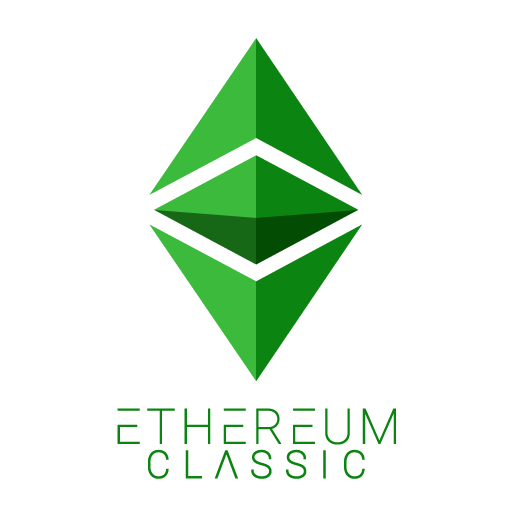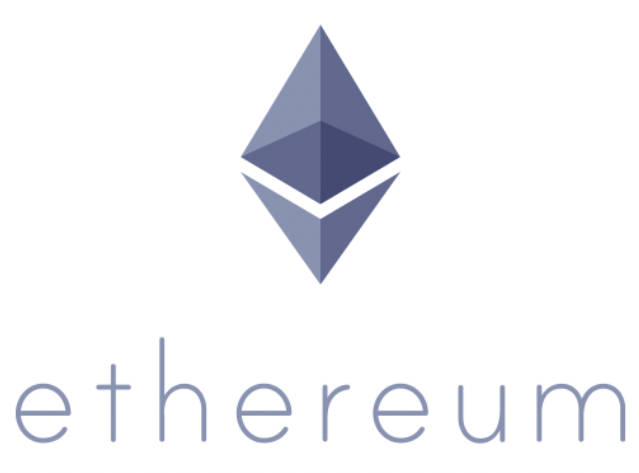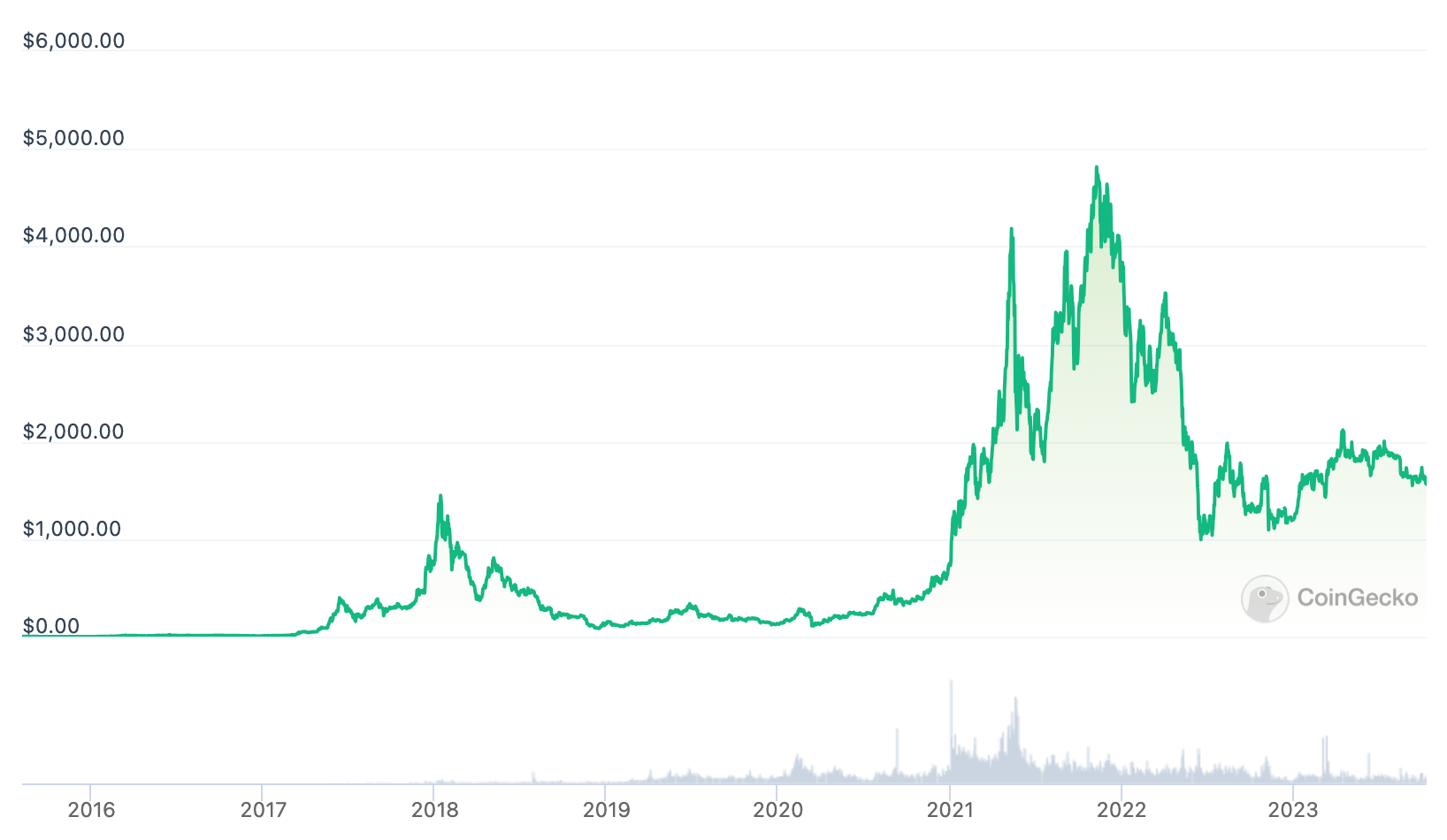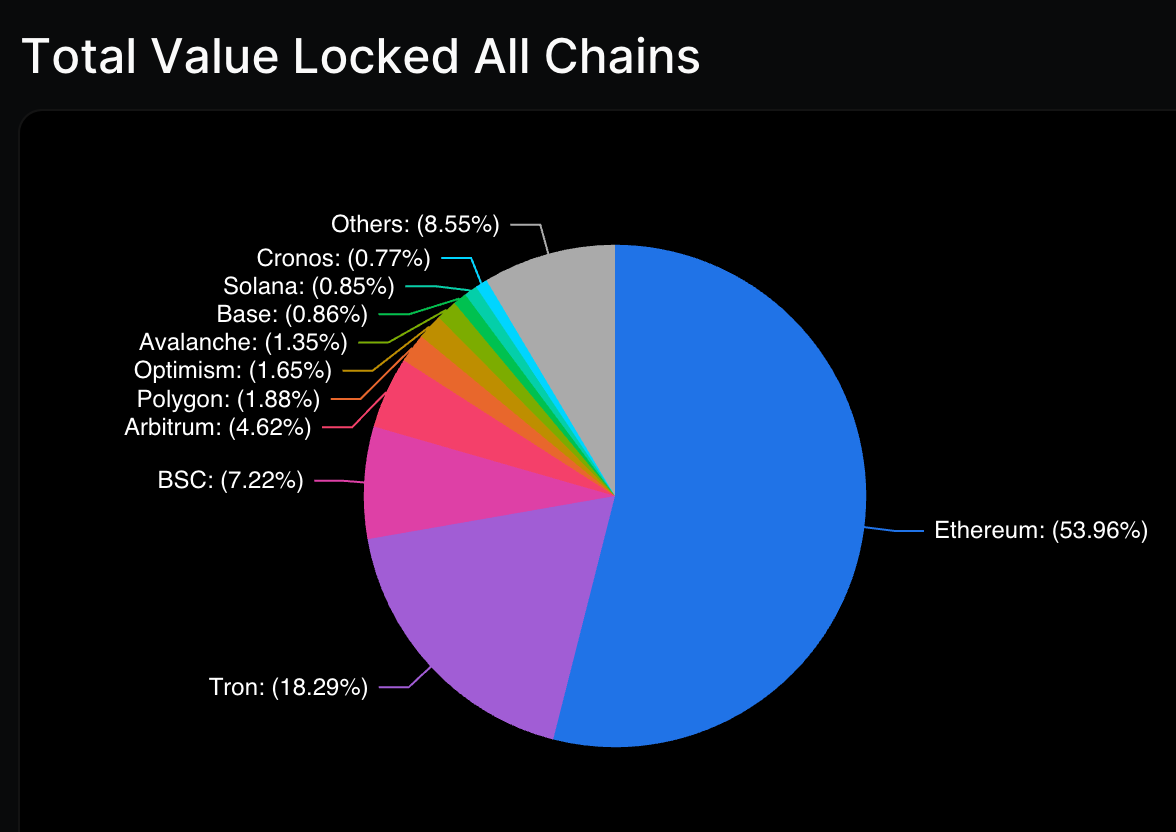Ethereum vs Ethereum Classic: What's the difference between ETH and ETC?
Table of Contents
- History of Ethereum
- Ethereum hard fork: Consequences of the DAO hack
- Ethereum Classic (ETC) explained
- Ethereum (ETH) explained
- Similarities between Ethereum and Ethereum Classic
- Differences between Ethereum and Ethereum Classic
- Should I invest in Ethereum or Ethereum Classic?
- Ethereum vs Ethereum Classic: Concluding thoughts
- How to buy Ethereum (ETH) and Ethereum Classic (ETC)
- How to sell Ethereum (ETH)
- Swap Ethereum for more tokens
Many who are new to crypto (and even some experienced users) don't understand the difference between Ethereum and Ethereum Classic. There tends to be a lot of confusion not just around which of these digital assets is the better investment, but also what differentiates the two blockchains in the first place.
This article provides a detailed side-by-side comparison of Ethereum and Ethereum Classic, highlighting their similarities, differences and future trajectories.
Before diving into a comparative analysis, it is important to understand why two separate blockchains with very similar names exist. To explain that, readers need to revisit one of the most important and controversial events in Ethereum's history…
History of Ethereum
A brief glimpse into the history of the Ethereum protocol will help readers grasp the implications of the 2016 DAO hack:
2013: Vitalik Buterin first proposed the idea of a programming language for automating on-chain tasks and building applications on the blockchain.
2014: Vitalik published the original Ethereum blockchain whitepaper, bootstrapping $17 million for the network.
2015: The original version of the Ethereum network went live and everything ran smoothly for a year. Ethereum co-founder Vitalik Buterin (Image source)
Ethereum co-founder Vitalik Buterin (Image source)
The 2016 DAO hack
In 2016, the launch of the decentralized autonomous organization known as “The DAO”, however, changed things for the new blockchain. The DAO was a decentralized venture capital fund enabling retail investor accounts to crowdfund projects on the Ethereum network. It successfully raised $150 million by selling DAO tokens. Retail clients could use the coins to vote and pledge their support for decentralized apps (dApps) on the network.
Unfortunately, DAO's smart contract code had a security vulnerability known as the ‘Split Function'. Originally, the smart contract included this feature to enable investors to withdraw their investment if they weren't satisfied with a project. If someone invoked the function, users would get their ETH back, and the smart contracts would update the public ledger accordingly.
Due to this security flaw, malicious hackers could receive money without updating the transaction history. On June 17, 2016, hackers exploited the code and drained $50 million from the project. This was a big blow to the nascent Ethereum network and the original ETH token owners had to do something about their stolen funds.
Ethereum hard fork: Consequences of the DAO hack
After the hack, Vitalik Buterin and other project developers felt that regaining the confidence of the Ethereum community was necessary. Users could only trust the Ethereum ecosystem again if they retrieved their money.
Ethereum developers initially proposed a soft fork so that the current and updated versions are mutually compatible. But this didn't materialize due to legal and technical issues. Instead, the network arrived at a consensus to hard fork Ethereum, which meant the creation of a new and backward-incompatible blockchain.
Ethereum vs. Ethereum Classic thus became an either / or choice.  A diagram showing a hard fork (Image source)
A diagram showing a hard fork (Image source)
The decision to hard fork the original Ethereum blockchain led to an ideological debate within the cryptocurrency community. Some argued that “code is law” and the immutability of the blockchain is sacrosanct. The hack should therefore remain part of the transaction history.
The counterargument was that retrieving the money is of paramount importance and transactions should be altered if necessary.
After a heated debate, the decision was put to a vote. The community voted in favor of the hard fork and the developers implemented it on July 20, 2016, after the 192,000th block.
Thus, a single blockchain forked to become two distinct networks:
The pre-forked version of the blockchain came to be known as the Ethereum Classic Network, which contained the record of the hack. The Ethereum blockchain reversed the hack and returned the money to its users.
Ethereum Classic (ETC) explained
Ethereum Classic (ETC) emerged as the unaltered version of Ethereum (ETH) and derived its name after forking the network. Anonymous developers vehemently upheld the immutability of blockchain technology and convinced others to maintain the transaction record of the old Ethereum.  The Ethereum Classic logo (Image source)
The Ethereum Classic logo (Image source)
The open-source and decentralized Ethereum Classic interface supports decentralized applications and runs on the Proof of Work consensus mechanism. Ethereum Classic users rely on the native ETC cryptocurrency to power transactions on the platform.
Ethereum (ETH) explained
Ethereum compromised on the immutability principle to return money to its users after forking the blockchain. Vitalik Buterin and the Ethereum Foundation garnered support for the platform, which eventually became famous in the crypto community.
The popular cryptocurrency Ether (ETH) powers the Ethereum platform. Ethereum has distinguished itself from other blockchains through its compatibility with dApps that run on smart contracts, and has since become the main hub for decentralized finance (DeFi).  The Ethereum logo (Image source)
The Ethereum logo (Image source)
After using a Proof of Work consensus protocol for most of its existence, Ethereum completed the process of migrating to a Proof of Stake (PoS) system on September 15, 2022.
Also known as Ethereum 2.0, the new PoS version of ETH includes a roadmap with several upgrades to the network, mostly in the name of greater scalability, faster transactions, and lower gas fees.
Similarities between Ethereum and Ethereum Classic
Both Ethereum and Ethereum Classic function as a store of value, facilitating trades and exchanges with other cryptocurrencies. Here are some other similarities between them:
Decentralized blockchain technology
Ethereum continues to be a decentralized protocol similar to Ethereum Classic with its globally distributed blockchain nodes that eliminate single points of failure and process transactions 24/7.
Smart contract functionality
Both Ethereum and Ethereum Classic automate decentralized applications and financial decisions using smart contracts. A smart contract is essentially self-executing code that can perform actions based on predefined conditions.
Privacy protection
Ethereum and Ethereum Classic both put great emphasis on protecting the privacy of their users. While public keys are open for everyone, private keys remain under the user's exclusive control. Users are also free to use aliases instead of their name and other details, preserving their anonymity while carrying out transactions.
Differences between Ethereum and Ethereum Classic
The difference between Ethereum and Ethereum Classic comes down to factors like minting limit, price, market cap, and consensus protocol.
Minting limit
According to the monetary policy of Ethereum, there is no hard cap on its supply, which can increase indefinitely. However, developers have programmed the supply of Ethereum to increase by 4.5% only every year.
The monetary policy of Ethereum Classic, on the other hand, stipulates a fixed supply of its tokens. There can only ever be 230 million Ethereum Classic tokens, which is meant to ensure a fair price.
Market value and price
At the time of writing, the Ethereum price is around $1,500 (remember that prices are subject to constant change).
ETH is the second-largest cryptocurrency (after Bitcoin) with a market capitalization of $188 billion and a circulating supply of over 120 million tokens. Ethereum reached an all-time high of $4,891.70 on November 16, 2021. ETH reached an all-time high of $4,891.70 on November 16, 2021 (Image source)
ETH reached an all-time high of $4,891.70 on November 16, 2021 (Image source)
Ethereum Classic has a price of just under $15 at the time of writing.
ETC has the 29th largest market cap of all cryptocurrencies at $2.1 billion, with a circulating supply of over 143 million tokens. Ethereum Classic reached its all-time high of $176 on May 6, 2021. ETC reached an all-time high of $176 on May 6, 2021 (Image source)
ETC reached an all-time high of $176 on May 6, 2021 (Image source)
Consensus protocol
Ethereum Classic runs on the Proof of Work consensus mechanism. Through this process, miners solve complex mathematical problems using energy-intensive equipment to gain rights for validating transactions on the blockchain. By successfully validating and adding new blocks, they get ETC tokens as rewards.
Ethereum used to run on the Proof of Work consensus model, but made the shift toward the Proof of Stake mechanism where nodes must stake Ether tokens to become validators. Staking ensures that validators won't add any dubious transaction to a block. This shift from PoW to PoS is known as the Merge and took place in September of 2022.
Recommended reading: Proof of Work vs Proof of Stake
Should I invest in Ethereum or Ethereum Classic?
Now that you know the similarities and differences between Ethereum and Ethereum Classic, the obvious question is where to put your money.
As the above section amply demonstrates, Ethereum Classic's valuation is negligible compared to Ethereum's. Consequently, Ethereum has emerged as one of the most successful blockchains for building valuable DeFi apps and launching NFT projects Ethereum dominates 54% of DeFi TVL (Image source)
Ethereum dominates 54% of DeFi TVL (Image source)
At the time of writing, the total value locked (TVL) in DeFi sits at $36 billion, with Ethereum dominating the market at $19.85 billion. Although this is down from its 2022 high of $125 billion, Ethereum has consistently controled well over 50% of the DeFi TVL, with additional billions TVL in Ethereum cross-chain bridges.
Though its monthly trading volume is down from its all-time high of $5.36 billion in January 2022, Ethereum is by far the most popular blockchain for NFTs (non-fungible tokens). It has also set a daily record of $476 million in Ethereum NFTs traded on the OpenSea marketplace.  Ethereum NFTs dominate the NFT marketplace (Image source)
Ethereum NFTs dominate the NFT marketplace (Image source)
The data speaks for itself. Ethereum is currently one of the strongest ecosystems for investment consideration. However, that doesn't mean Ethereum Classic is worthless. With a strong community that firmly believes in the principles of immutability, Ethereum Classic is still a promising cryptocurrency asset.
Earn interest in Ethereum and Ethereum Classic
One way to earn interest is to deposit your Ethereum and Ethereum Classic tokens in yield farming protocols, liquidity pools, and other lending platforms. These platforms use the funds for loans, offering you a competitive interest rate for your deposit. Despite relative stability, however, interest rates may fluctuate depending on the supply-demand ratio.
Ethereum users can also stake ETH to earn interest. You can choose to stake Ethereum independently using an Ethereum wallet or do so on a crypto exchange. You will need a minimum of 32 ETH to independently participate in staking, but for exchanges there is no fixed staking amount since they aggregate the funds from multiple investors.
Recommended reading: What is crypto staking?
Ethereum vs Ethereum Classic: Concluding thoughts
Ethereum is not the only network to have undergone forking. The Bitcoin community also faced a similar dilemma in 2017 when it forked and Bitcoin Cash was born. The forking of the Ethereum blockchain is therefore not an exceptional incident in cryptocurrency history, and it didn't permanently solve Ethereum's problems.
For instance, despite its transition to ETH 2.0, Ethereum suffers from scalability issues and causes environmental damage. In recent years, Ethereum Classic has been subject to three 51% attacks in a month, significantly hurting its reputation. Nevertheless, both blockchains have adopted measures to rectify these flaws.
With a better understanding of ‘immutability politics', Ethereum Classic implemented the Atlantis hard fork in 2019 to improve its compatibility with Ethereum. Soon after, it also implemented the Agharta hard fork to ensure complete compatibility between ETH and ETC.
Similarly, the Ethereum 2.0 upgrade was completed in 2022, giving the Ethereum blockchain network enhanced scalability, speed, low ETH gas fees, and lower carbon emissions. With these modifications, Ethereum will continue to become far more efficient than it has ever been.
Overall, we can expect better communication and interaction between Ethereum and Ethereum Classic, with both chains contributing to the crypto industry's future.
How to buy Ethereum (ETH) and Ethereum Classic (ETC)
Now that you have a good understanding of Ethereum vs Ethereum Classic, you might want to buy these tokens for yourself.
You can buy Ethereum (ETH) and Ethereum Classic (ETC) via MoonPay or through any of our partner wallet applications with a credit card, bank transfer, Apple Pay, Google Pay, and many other payment methods.
How to sell Ethereum (ETH)
MoonPay makes it easy to sell Ethereum when you decide it's time to cash out your crypto.
Simply enter the amount of ETH you'd like to sell and enter the details where you want to receive your funds.
We're always adding more cryptocurrencies like Ethereum Classic (ETC) to sell, so check back soon.
Swap Ethereum for more tokens
Want to exchange Ethereum for other cryptocurrencies like Ethereum Classic and Bitcoin? MoonPay allows you to swap crypto cross-chain with no processing fees, directly from your non-custodial wallet.
























![[ℕ𝕖𝕧𝕖𝕣] 𝕊𝕖𝕝𝕝 𝕐𝕠𝕦𝕣 𝔹𝕚𝕥𝕔𝕠𝕚𝕟 - OM(G) , My Biggest Bag Was A Scam????](https://cdn.bulbapp.io/frontend/images/99de9393-38a8-4e51-a7ab-a2b2c28785bd/1)



























